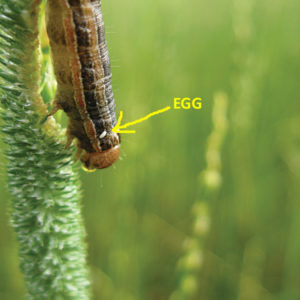True armyworm (TAW) has been spotted at near threshold levels in a winter wheat field near Niagara and has also caused significant damage in late planted seedling corn in Chatham Kent. Though most of our YEN wheat sites being scouted weekly have picked up only low levels of TAW in a few of the sites, it would be worth scouting both winter and spring wheat fields as well as other at risk crops these next few weeks. At risk crops include wheat, mixed forages and corn before V6 stage.
Scouting Guidelines: The best time to scout for true armyworm is shortly after dusk when larvae are actively feeding. In cereals and mixed forages, examine 10 areas of the field, assessing the number of larvae per 30 cm x 30 cm (1 ft2). Pay particular attention to the border area directly adjacent to other grassy host crops. During the day, if it is cloudy and overcast, you might be lucky enough to see larvae on the head of the plant but on sunny days, they will be down on the ground among the crop debris or under soil clods. Brown frass may also be present on the plants and on the soil surface. Birds diving into your field is a good indication that there are good eats there so take a look.

When you do find larvae, look for any white eggs that may be attached to the backs of the armyworm larvae. This is a sign that the larvae have been parasitized by one of its parasites which have done the job for you. Avoid treating with insecticides when large numbers of parasitized larvae are present as they have already been controlled by parasitoids or when larvae are close to 2.5 cm in length, as insecticides will no longer be effective and the larvae will soon stop feeding.
Threshold for Cereals: Chemical control is warranted if there are 4 to 5 un-parasitized larvae (smaller than 2.5 cm) per square foot. If a significant amount of wheat head clipping is occurring, spray may be warranted if larvae are still actively feeding, are smaller than 2.5 cm and as long as pre-harvest intervals have not been reached.
Threshold for Mixed Forages: Control is warranted when 5 or more un-parasitized larvae (smaller than 2.5 cm) per square foot are found. In seedling crops, two to three larvae (smaller than 2.5 cm) per square foot may warrant control.
Threshold for Corn: Control may be warranted in seedling corn if there are 2 or more un-parasitized
larvae per seedling, or if 10% or more of the plants have feeding and larvae are smaller than 2.5 cm (1 in.).
For corn past the 6-leaf stage, if 50% of the plants have leaf-feeding damage and are infested with larvae
smaller than 2.5 cm (1 in.), insecticide treatment may be warranted. As long as the growing point of the
plant is not damaged, the corn plant is usually able to recover from moderate feeding.
Cereal leaf beetle (CLB) is also present at low levels in winter and spring wheat fields with the exception of a couple of fields that required management in the last week. While you are scouting for true armyworm, be on the lookout for CLB too. In winter wheat, control is only warranted if feeding is taking place on the flag leaf in the early heading stages. In spring cereals, control is warranted if an average of three larvae per tiller are found before boot stage. One CLB adult or larvae per stem warrants control after boot but prior to heading.
Use the Crop Protection Hub to find products registered on these crops for true armyworm or cereal leaf beetle. A reminder that lambda-cyhalothrin products (Matador, Silencer, Voliam Xpress) are not to be used on crops that could end up in livestock feed.
3 thoughts on “Watch for True Armyworm and Cereal Leaf Beetle”
Comments are closed.